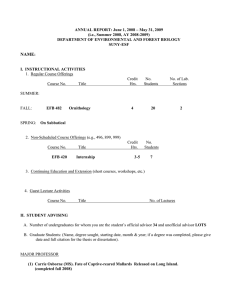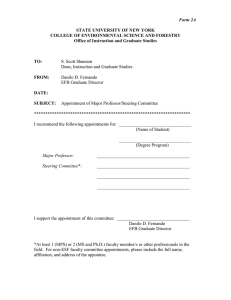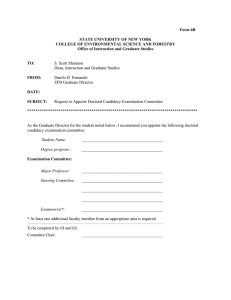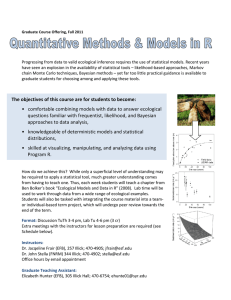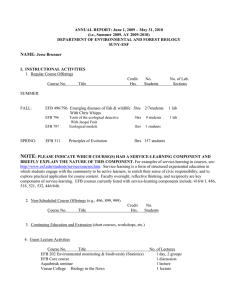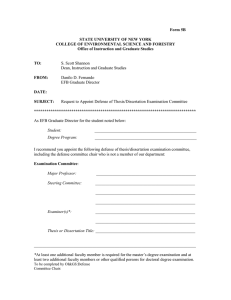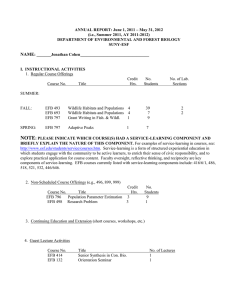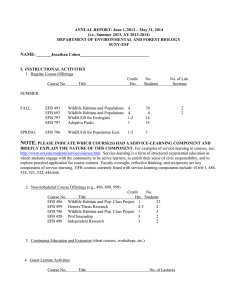ANNUAL REPORT: June 1, 2010 – May 31, 2011
advertisement
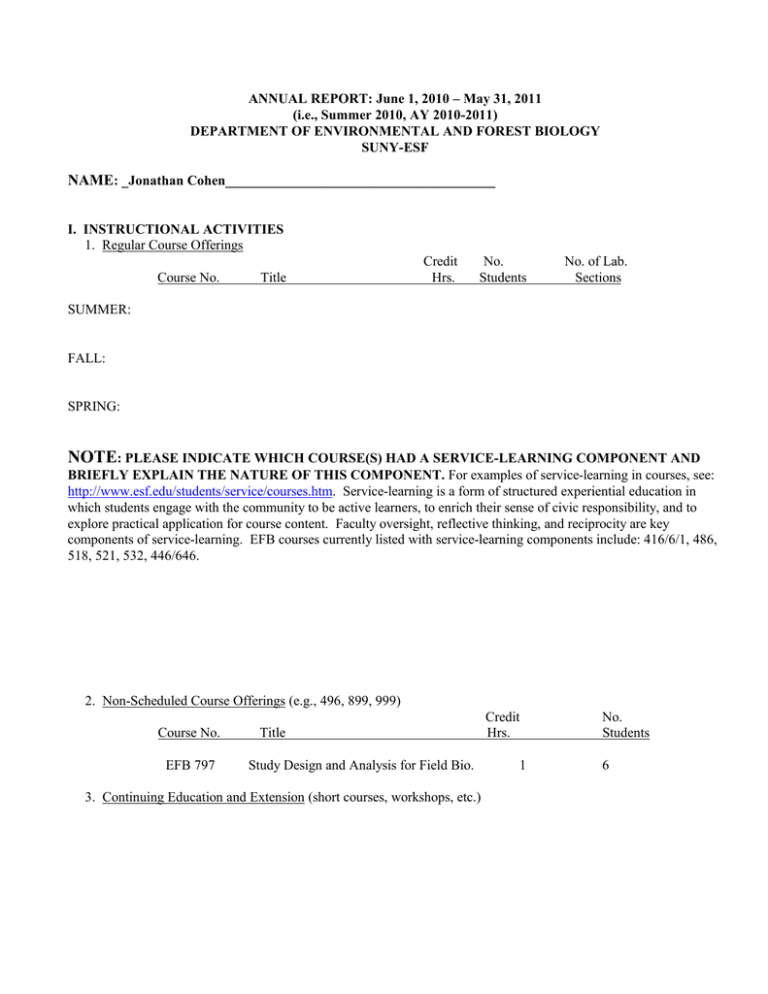
ANNUAL REPORT: June 1, 2010 – May 31, 2011 (i.e., Summer 2010, AY 2010-2011) DEPARTMENT OF ENVIRONMENTAL AND FOREST BIOLOGY SUNY-ESF NAME: _Jonathan Cohen_______________________________________ I. INSTRUCTIONAL ACTIVITIES 1. Regular Course Offerings Course No. Title Credit Hrs. No. Students No. of Lab. Sections SUMMER: FALL: SPRING: NOTE: PLEASE INDICATE WHICH COURSE(S) HAD A SERVICE-LEARNING COMPONENT AND BRIEFLY EXPLAIN THE NATURE OF THIS COMPONENT. For examples of service-learning in courses, see: http://www.esf.edu/students/service/courses.htm. Service-learning is a form of structured experiential education in which students engage with the community to be active learners, to enrich their sense of civic responsibility, and to explore practical application for course content. Faculty oversight, reflective thinking, and reciprocity are key components of service-learning. EFB courses currently listed with service-learning components include: 416/6/1, 486, 518, 521, 532, 446/646. 2. Non-Scheduled Course Offerings (e.g., 496, 899, 999) Course No. EFB 797 Title Study Design and Analysis for Field Bio. 3. Continuing Education and Extension (short courses, workshops, etc.) Credit Hrs. 1 No. Students 6 4. Guest Lecture Activities Course No. Title EFB 797 Core Seminar No. of Lectures 1 (led discussion) II. STUDENT ADVISING A. Number of undergraduates for whom you are the student’s official advisor _____ and unofficial advisor _____ B. Graduate Students: (Name, degree sought, starting date, month & year; if a degree was completed, please give date and full citation for the thesis or dissertation). MAJOR PROFESSOR Maureen Durkin, M.S., August 2011 (accepted, coming) Laurel Nowak-Boyd, M.S. August 2011 (accepted, coming) CO-MAJOR PROFESSOR Michelle Peach, Ph.D., August 2009 (with Jacqui Frair) Anand Chaudhary, M.S., August 2011 (accepted, coming, Fulbright, I will possibly be sole advisor or co-advise with Dr. Gibbs) MEMBER, STEERING COMMITTEE (other than those listed above) Joshua Stiller (EFB, M. S.) Kevin Shoemaker (EFB, Ph. D., defended) Jason Townsend (EFB, Ph. D., defended) Lewis Grove (EFB, Ph. D.) Katharine DeVilbiss (EFB, M.S.) CHAIRMAN OR READER ON THESIS EXAMS, ETC. III. RESEARCH COMPLETED OR UNDERWAY A. Departmental Research (unsupported, boot-legged; title - % time spent) Stopover Ecology of Red Knots in Virginia – 1% B. 1. Grant-supported Research (source, subject, amount - total award and current year, award period starting and ending dates; list graduate research assistants supported by each grant) Population Viability Analysis of Florida Snowy Plovers – U.S. Fish and Wildlife Service, $20,000 2011. 1/2011 – 12/2014, will support Maureen Durkin in Spring 2012 semester. 2. Research Proposals pending (include information as in B.1., above). Fall Migratory Staging of Roseate Terns in Massachusetts: Distribution, Abundance, and the Effects of Human Activities – National Park Service. $311,569. Year 1 $52,746. 5/11 – 8/12. Michelle Stantial. A critical test of the effectiveness of protected lands for conserving forest bird biodiversity and mitigating the effects of climate change. USDA Northeastern States Research Cooperative. $90,799. Year 1 $46,105. 9/11 – 8/13. Michelle Peach. 3. Research Proposals submitted, but rejected (include information as in B.1, above) Fall Migratory Staging of Roseate Terns in Massachusetts: Distribution, Abundance, and the Effects of Human Activities – U.S. Fish and Wildlife Service Neotropical Migratory Bird Conservation Act. $97,131. 5/11 – 8/12. Michelle Stantial. Effect of Human Disturbance on Snowy Plover Productivity and Behavior – SUNY-ESF SEED grant. $8,000. 5/11 – 8/11. Maureen Durkin A critical test of the effectiveness of protected lands at conserving forest bird diversity. SUNY-ESF McIntire-Stennis. $41,085, Year 1 $20,444. 1/11 – 12/12. Michelle Peach. IV. PUBLICATIONS (Full bibliographic citation, i.e., do not use "with Jones," or "Jones, et al."; please list only publications published, in press, or actually submitted during this reporting period --- do not list manuscripts in preparation). A. Refereed Publications Cohen JB, Gerber BD, Karpanty SM, Fraser JD, and Truitt BR. In press. Day and night foraging of Red Knots (Calidris canutus) during spring stopover in Virginia, USA. Waterbirds. Karpanty SM, Cohen JB, Fraser JD, Berkson J. In press. Effect of foraging birds on horseshoe crab egg resources during spring migratory stopover in Delaware Bay. Journal of Wildlife Management. Catlin DH, Fraser JD, Felio JH, Cohen JB. 2011. Piping plover nest success on natural, managed, and engineered Missouri River sandbars. Journal of Wildlife Management 75:305-310. Cohen JB, Gratto-Trevor C. Submitted, in review. Survival, site fidelity, and population dynamics of piping plovers in Saskatchewan. Journal of Field Ornithology. B. Non-refereed Publications Effect of human disturbance on Snowy Plover behavior and reproductive success. Final report submitted to Conservian, Inc., Big Pine Key, FL C. Papers Presented at Science Meetings (give title, date, occasion, and location) Deepwater Horizon Oil Spill-Lessons Learned. 3/15/2011, 34th Annual meeting of the Waterbird Society, Grand Island Nebraska. This was a Symposium that I organized and moderated. D. Public Service Presentations (lectures, seminars, etc. to and for the public; give group or occasion, date(s), and attendance) V. PUBLIC SERVICE A. Funded Service (include consulting activities) 1. Government Agencies (Federal, State, Local): 2. Industrial and Commercial Groups, etc. Effect of human disturbance on Snowy Plover behavior and reproductive success. Conservian, Inc. (private nonprofit). Provided statistical advice and analysis for a behavioral study, produced final report. B. Unfunded Service to Governmental Agencies, Public Interest Groups, etc. Appointed to the advisory board for the Goldenrod Foundation, a private conservation nonprofit based in Plymouth Massachusetts. Attended board meeting 4/22/2011. Appointed as an advisor to the U.S. Shorebird Conservation Plan (US Fish and Wildlife Service) VI. PROFESSIONAL DEVELOPMENT A. Professional Honors and Awards (for teaching, research, outreach, etc.) B. 1. Activities in Professional Organizations (offices held, service as chairman, member, participant or consultant) The Waterbird Society, Chair of Conservation Committee 2. Professional Society Membership The Wildlife Society The Waterbird Society American Ornithologists Union Association of Field Ornithologists Wilson Ornithological Society American Association for the Advancement of Science Sigma Xi 3. Other Professional Activities a. Editorial activity Journal (s) Other (books, symposia, etc.) Responsibility b. Reviewer Journal(s) Avian Conservation and Ecology Auk Journal of Animal Ecology Journal of Field Ornithology Journal of Ornithology Journal of Raptor Research Waterbirds Agency No. of manuscripts 1 1 1 1 1 1 1 No. of proposals Other c. Participation (workshops, symposia, etc.) Name of workshop, etc. Date Place C. Further Education/Re-training Undertaken, Leaves, Workshops, etc. D. Foreign Travel (Where, When, Purpose) VII. ADMINISTRATIVE AND SERVICE RESPONSIBILITIES (include committee participation) A. Department-level Faculty advisor for student chapter of The Wildlife Society (service to begin Fall 2011) B. College-level Research Committee (service to begin July 2011) Reviewer for Sussman Internship Applications Reviewer for Burgess Award Applications C. University-wide, including Research Foundation VIII. SUMMARY OF SIGNIFICANT ACTIVITIES AND ACCOMPLISHMENTS DURING THIS REPORTING PERIOD, ESPECIALLY THOSE MOST NOTEWORTHY AND RELATIVE TO THE COLLEGE’S AND DEPARTMENT’S MISSION. One paragraph on each of the following would be most helpful: this past year, what have you done for our students, department/college, and self professionally? NOTE: The information in this section (along with the supporting specific information elsewhere in this report) should be your strongest case for being considered for a discretionary raise, which I’ll continue to award based on your contributions to the department and college this reporting period. I began my career at SUNY-ESF in January, 2011, so this was a very exciting time for me. One of my primary goals was to get to know the department and college, the faculty and of course the students. As I was not teaching an undergraduate course, I decided to interact with at least a small portion of the wildlife majors by getting involved with the student chapter of The Wildlife Society. I attended several meetings and enjoyed learning about the club’s activities and goals and about the students themselves. By the semester’s end I agreed to assume the role of the faculty advisor for the club. I also offered a graduate seminar entitled “If I only knew then: design and analysis considerations for field biology studies.” Although enrollment was light at 6 students, I was thus able to spend a good deal of time with individual students, assisting them with the class exercises and discussing their graduate projects. One of the students was at the AEC, which gave me the opportunity to get familiar with distance learning technologies. Several graduate students who wished to enroll but had schedule conflicts visited me on the side to talk about their projects as well. I was also pleased to have been invited to serve on several committees. In two of those cases I replaced faculty who left EFB, and in that way obtained my first two experiences as an examiner at dissertation defenses. I also assumed a co-advisor role for Ph.D. candidate Michelle Peach, and began working with her and Dr. Frair to obtain GRA funding, starting in November 2010. Through a collaboration with Conservian, a private nonprofit based in Florida, I recruited my first M.S. student, Maureen Durkin, who was accepted with a teaching assistantship, and I received a $20,000 grant to support her on a GRA for one semester (Spring 2012). To meet my goal of becoming involved in the campus and department community as quickly as possible, I made it a point to attend department and faculty governance meetings and graduate seminars as often as possible. I put myself forth and was recruited to serve on the Research Committee, and my service will begin with a meeting in July. I also accepted requests to serve on two review panels. The first was for the Sussman Foundation internship which required reviewing ~30 proposals and meeting with the other reviewers to select the finalists. The other was for the Burgess Award. For my own professional development, I continued to wrap up some loose ends (manuscripts) left over from my post-doctoral career. Two were accepted and are in press, and I anticipate one more submitted possibly by the end of the month, but by mid-June at the latest. I also spent three days in the field helping to wrap up a final year of my post-doctoral field work. The aim was also to ensure a sixth year of results that would qualify the project for NSF long term research funding, and I plan on collaborating on a proposal to obtain such funding. I reviewed several manuscripts for various ecological and ornithological journals. I also continued my second year as Chair of the Conservation Committee for The Waterbird Society. I oversaw the preparation and submission of two advocacy letters and organized a symposium for the Society’s annual meeting related to the Gulf Oil Spill. The symposium had 8 speakers and was attended by 25-100 people depending on the particular session, and there was a call for a followup at the next meeting. I have been asked to run for elected Councilor of the Society and agreed. I was asked to join the advisory board for The Goldenrod Foundation, a private conservation nonprofit in southeastern Massachusetts and I attended the first meeting in February. I have also agreed to serve as an advisor to the U.S. Shorebird Conservation Plan by the U.S. Fish and Wildlife Service. Finally, I participated in a weekly discussion group with Dr. Frair and several graduate students in EFB in which we improved our skills at Bayesian statistics (in my case from near zero at the outset). IX. A. FUTURE PLANS, AMBITIONS, AND POTENTIAL CONTRIBUTIONS FOR YOUR OWN PROFESSIONAL DEVELOPMENT AND THE ENHANCEMENT OF THE PROGRAM IN ENVIRONMENTAL AND FOREST BIOLOGY (brief summary) One of my near-term ambitions for contributing to EFB is to revisit the undergraduate wildlife curricula and the graduate course offerings with Drs. Frair and Baldassarre and other interested faculty. It may be that only minor changes if any are required, once we start delving into the question as we hope to start doing in the next week or so. However, Dr. Frair has discussed with me that it might be useful to examine how integrated the wildlife curriculum is from Freshman to Senior year (i.e., how well the courses build on each other). Also certain components may need to be enhanced or added, for example a semester-long wildlife techniques course might help our undergraduates compete better right out of school, when they must go up against experienced field technicians when applying for seasonal field jobs. My most important contribution will be the teaching of EFB 493, and I plan on spending much of the summer going through the course and preparing for it, especially as several people have suggested that updates may be necessary. As for the graduate curriculum Dr. Frair and I plan on beginning a discussion on gaps in what we offer. I will be developing a course for next Spring that will likely be quantitative, but which may evolve somewhat before I post it, as I discuss it with other faculty and graduate student in the coming weeks. The other way I hope to contribute to the department in the near term is to improve my success at bringing in larger grants. This is something I have worked a great deal on over the last several months, starting before my time here. I am continuing to identify collaborators with interest in my research and to develop relationships with funding agencies. I will also be looking into the NSF Career grant. I also plan to remain involved in college and department activities, building on things I have begun to do this past semester including providing reviews for proposals and serving on graduate committees. For my professional development and activities, I plan on attending at least one professional meeting in the coming year with my graduate students and having one of them present on her work to date. I will run for elected office in the Waterbird Society and will continue to serve as Conservation Chair. In the much longer term, I have the ambition to one day serve as an associate editor for a peer reviewed journal in wildlife or ornithology. But over the next few years I will likely satisfy myself with serving as a reviewer, as I build my research and teaching program here. B. PROJECTED ACTIVITIES FOR NEXT YEAR 1. Summer 2011 a. Course(s) to be offered None. I intend to visit CLBS in July to observe the ornithology instructor, in preparation for offering a field ornithology course in 2012. b. Proposed research activity M.S. student Maureen Durkin will continue to collect data for her project on effects of disturbance on Snowy Plovers. c. University, professional society, and public service First meeting of Research Committee to be in July 2. Fall Semester 2011 a. Course(s) to be offered EFB 493: Wildlife Habitat and Populations b. Proposed research activity Commence graduate program for Laurel Nowak-Boyd (ESF internship with NYDEC to study Ring-necked Pheasants in Western NY, field season to begin following spring) Commence graduate program for Anand Chaudhary (tentative, Reproductive success and behavior of screech owls along the Hudson River, field season to begin following spring) Commence graduate program for Michelle Stantial (depending on support for fall, Post-Fledging Disturbance of Roseate Terns in Cape Cod, field work to begin following summer) Commence graduate program for Alison Kocek (depending on support for spring, Reproductive Success and Abundance of Saltmarsh Sparrows in New York City, field work to begin the following spring) Effectiveness of land protection at conserving avian biodiversity in the northern forest (Michelle Peach) Effect of human disturbance on Snowy Plover reproductive success and behavior in Florida (Maureen Durkin) c. University, Professional society, and public service Research Committee, SUNY-ESF Advisor, student chapter of TWS Advisory board for Goldenrod Foundation and U.S. Shorebird Conservation Plan Chair of Conservation Committee, the Waterbird Society Stand for elected Council, Waterbird Society Continue to serve as reviewer for various journals 3. Spring Semester 2011 a. Course(s) to be offered Probably: EFB 797 (3-4 credits) Advance Habitat and Population Estimation b. Proposed research activity Continuation of Fall projects c. University, professional society, and public service Similar to Fall, in addition: Sussman Internship reviewer Burgess Award reviewer
